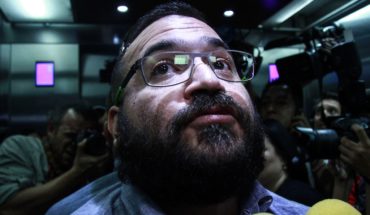Martha Eugenia Juarez, 68, got up very early to prepare some quesadillas and a coffee. It was a different Sunday, it was special because the Cablebus was inaugurated and she had to know it… going to the market to run the errand of the week might wait.
After breakfast he left his home in the vicinity of the Military College subway, in the mayor’s office of Miguel Hidalgo, and went to Indios Verdes, in Gustavo A. Madero. She says that never in her life had she reached there, the most retired thing she knew was the Potrero subway, much less had she visited Cuautepec, but yesterday was a day of adventures and she was willing to live them all.
And her family did not want to accompany her?, she was asked while she was in line waiting for her turn to get on the Cablebus.
“I live alone, well, God is with me,” he said.
Photo: Dalila Sarabia
You may be interested in: Route, schedules, cost: what you should know about line 1 of the CDMX Cablebus
From noon, the woman lined up – as did hundreds of others – to get on the 9.2-kilometer-long cable car, the largest in the world.
For a moment he thought they wouldn’t let them go up because time passed and they wouldn’t open the doors. When they asked, a surveillance element reported that maybe they would open at 14:00 hours, and if they did not give them the authorization it would be until 17:00 hours. He even advised them to come back in the week as there would be fewer people.
Photo: Dalila Sarabia
At the top of the line was Mr. José Ventura who arrived at Indios Verdes around 08:00 hours. In the news he found out that they were going to inaugurate the Cablebus and he wanted to get on the gondolas that he saw so much on television.
“I go very often to Barrio Alto, there we have acquaintances and for the truck we do two and a half hours, it is very heavy to cross from here to there, any people who go do their two and a half or three hours because there are some small streets and a lot of traffic, then (with the Cablebus) they will benefit a lot” , the man said.
“Now we’re supposed to do half an hour, so give him a two and a half or three that we did because now I think that’s going to be alleviated.”
José lives in Azcapotzalco and was the first in line to enter, however, as the hours passed the hunger was becoming present and he had to look in the street stalls for something to eat. Although he left his place away, within minutes of leaving, staff of the Secretariat of Mobility (Semovi) began to organize people to be located at another door so they could enter. Joseph lost his place.
Photo: Dalila Sarabia
Further back in line, Martha Eugenia was not disappointed and waited patiently. Meanwhile, vendors of bottle covers and snacks began to offer their products. “Take your boot cover so that they let you go up (to the Cablebus),” promoted a woman who sold masks with the image of superheroes. And it is that on this first day of operation and with the increase in confirmed cases of Covid-19, those who did not wear masks or did not have it well placed were not allowed to enter.
Around 13:30 hours the curtain of the station was lifted -without missing who applauded- and the entrance of the people began although this was in droppers. Around 2:40 p.m., it was Martha Eugenia’s turn to board one of the gondolas.
“This is spectacular, it looks great,” was the first thing he said.
The first few minutes of the trip were a little tense for the six people in that basket, as it had barely risen, stopped for a few seconds and began to swing.
A voice came out of the horns and announced that the service would be resumed shortly. A few seconds later the gondolas continued their journey at a speed of six meters per second.
“Nothing happens, don’t panic, it feels like a plane… well, I have not climbed one, but that’s how it has to feel, “said a woman who is dedicated to selling fried foods outside the Metro Indios Verdes and who did not want to miss the opportunity to be one of the first to know the first line of the Cablebus that cost 2 thousand 925 million pesos.
The woman’s prank broke the tension a bit and the journey continued. Some looked for the house of a relative or acquaintance and were surprised when they saw the Peripheral or some school or green field, while a child of no more than six years and who was in the company of his mother, stuck his stuffed animals on the glass so that they could also enjoy the journey.
The free wifi in the stations and in the gondolas themselves took a back seat, people admired the view and enjoyed the experience.
A 28-minute journey
After waiting three hours to get on the Cablebus, Martha Eugenia toured the six cablebus stations in 28 minutes. By 3:20 p.m. I was already in Cuautepec.
“Should we get off?, but I go to Indios Verdes for my house,” the woman told semovi volunteers who opened the doors and asked to vacate the gondola. “Can’t I stay?, I just came to know,” he insisted.
But it wasn’t possible, she and the other five people had to get off.
“If he wants to return to Indios Verdes, he must go down and retrain,” one of the young volunteers told him.
That certainly wasn’t the answer Martha Eugenia was hoping for. As soon as he looked out one of the windows he realized that the line to enter the Cuautepec station was endless. There was no end in his end.
Waiting another two or three hours to get on and off was not an option for her or for three of the other users who shared the gondola with her.
“Let’s look for a taxi and we split it,” proposed the woman who sells frying and who at all times brought with her bag with chips and peanuts.
How they, dozens of people asked where the trucks passed or where there were taxis that would take them back to Indios Verdes.
After walking for a couple of minutes they reached a street where the continuous passage of vehicles could be seen. There they made the stop to a tolerated taxi. The driver told them he would charge them 50 pesos to take them back to the subway. About 35 minutes later they were back in Indios Verdes.
Each one put 15 pesos, but Martha Eugenia took 10 more pesos out of her bag and gave them to the taxi driver. Although he said he would charge 50 pesos in the end he received 70 pesos.
“If he was very father, very nice, I’m going to come back another day, since there aren’t many people. What is very bad that they do not warn before that to return you have to leave and wait again. Imagine those who carry small children, they can’t have them like that,” claimed the woman who before saying goodbye anticipated that she would return to the entrance line to ask semovi workers to inform them that to return a new line had to be made.
Read more: CDMX will have two cablebus lines: they will cross gam and Iztapalapa points
According to official data, the Cablebus has the capacity to move 5 thousand people per hour per direction. Each gondola has 10 seats, however, due to the pandemic it was determined that only six people will travel in each basket and the windows must be permanently open.
On this first day of operation the service was free. From this Monday the cost – regardless of the section traveled – will be 7 pesos and the payment must be made through the Integrated Mobility card of the CDMX.
What we do at Animal Politico requires professional journalists, teamwork, dialogue with readers and something very important: independence. You can help us continue. Be part of the team.
Subscribe to Animal Politico, receive benefits and support free journalism.#YoSoyAnimal





